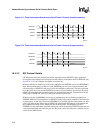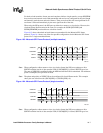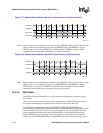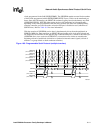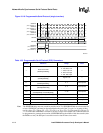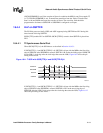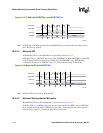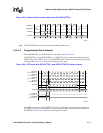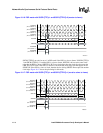
Intel® PXA26x Processor Family Developer’s Manual 16-13
Network/Audio Synchronous Serial Protocol Serial Ports
(SSCR1[SFRMDIR] is set) if the assertion of frame is not before the MSB is sent (For example, T5
<= T2 if SSCR1[SFRMDIR] is set). Transmit Data transitions from the “End of Transfer Data
State” to the next MSB value upon the assertion of frame. The start delay field should be
programmed to 0 whenever SSPSCLK or SSPSFRM is configured as an input.
16.4.4 Hi-Z on SSPTXD
The PXA26x processor family NSSP and ASSP support placing SSPTXD into Hi-Z during idle
times instead of driving SSPTXD.
SSCR1[TTE] enables Hi-Z on SSPTXD. SSCR1[TTELP] controls when SSPTXD is placed into
Hi-Z.
16.4.4.1 TI Synchronous Serial Port
When SSCR1[TTE] is 0, the SSP behaves as described in Section 16.4.3.1.
If SSCR1[TTE] is 1 and SSCR1[TTELP] is 0, SSPTXD is driven with the MSB at the first rising
edge of SSPSCLK after SSPSFRM is asserted. SSPTXD is Hi-Z after the falling edge of SSPSCLK
for the LSB (1 clock edge after the clock edge that starts the LSB). Figure 16-11shows the pin
timing for this mode.
If SSCR1[TTE] is 1 and SSCR1[TTELP] is 1, SSPTXD is driven with the MSB at the first rising
edge of SSPSCLK after SSPSFRM is asserted. SSPTXD is Hi-Z at the next rising edge of
SSPSCLK after the LSB (2 clock edges after the clock edge that starts the LSB). Figure 16-12
shows the pin timing for this mode.
Figure 16-11. TI SSP with SSCR[TTE]=1 and SSCR[TTELP]=0
A9974-01
SSPRXD
SSPSFRM
SSPSCLK
SSPTXD
MSB 4 to 32 Bits LSB
Bit[N] Bit[N-1] Bit[1] Bit[0]
Bit[N] Bit[N-1] Bit[1] Bit[0]
Undefined Undefined




